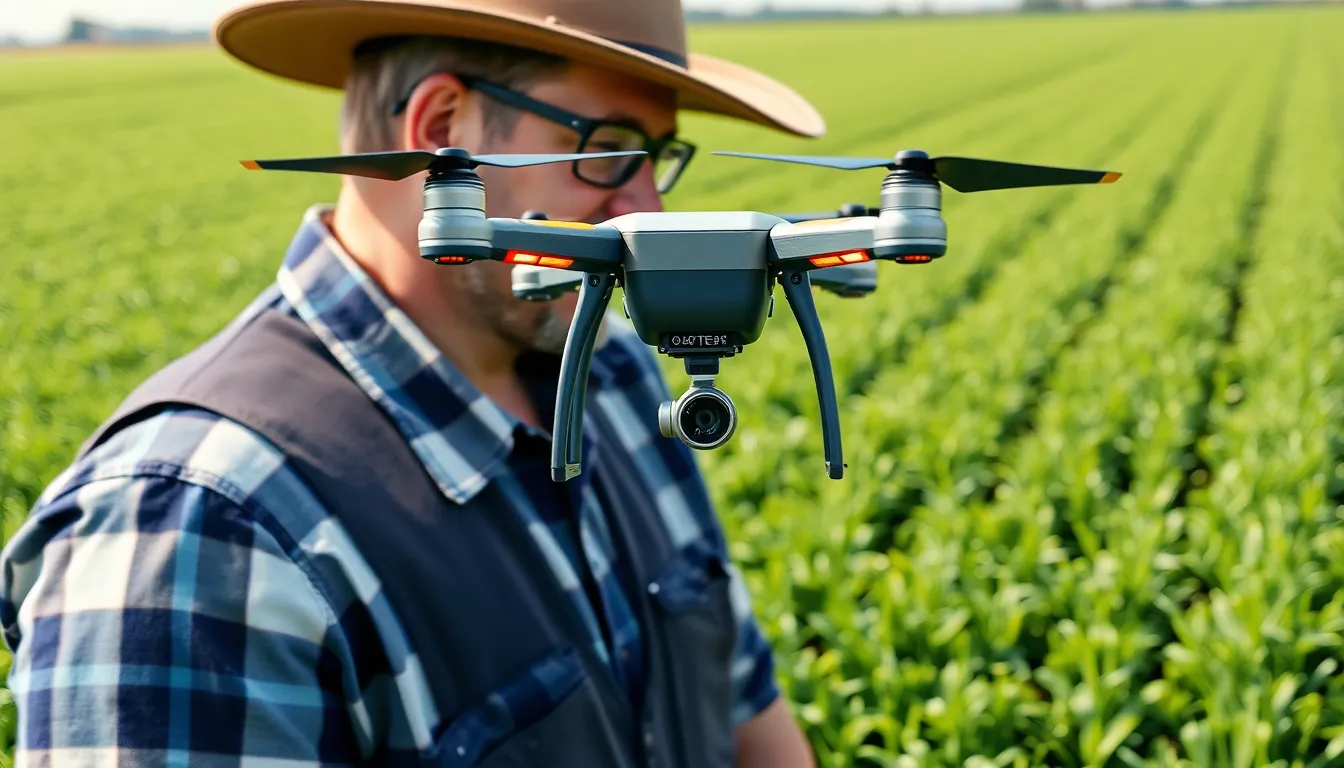The food industry is a wild ride, and it’s evolving faster than a chef can whip up a soufflé. With trends popping up like fresh ingredients at a farmer’s market, staying in the loop is crucial for anyone who loves food or works in the industry. From plant-based innovations to sustainable sourcing, there’s a lot to chew on in today’s culinary landscape.
As diners become more adventurous and health-conscious, the industry is responding with creativity and flair. It’s not just about what’s on the plate anymore; it’s about the story behind it. So, buckle up and get ready to explore the mouthwatering trends that are shaping how we eat, cook, and think about food. After all, in this fast-paced world, it’s not just about keeping up—it’s about savoring every delicious moment.
Table of Contents
ToggleOverview of Food Industry Trends
The food industry experiences constant evolution, driven by diverse consumer preferences and innovative practices. Current trends reflect a deeper awareness of health, sustainability, and culinary exploration.
Plant-Based Innovations
Plant-based diets gain momentum as consumers seek healthier options. Products like plant-based meat substitutes and dairy alternatives have surged. In 2022, the plant-based food market reached $7 billion in the United States, showcasing significant growth. Brands like Beyond Meat and Impossible Foods lead the market, appealing to a variety of consumers.
Sustainable Sourcing
Sustainable sourcing becomes critical for food companies. Consumers prioritize transparency regarding ingredients and production practices. Research indicates that 70% of millennials are willing to pay extra for sustainably sourced products. Efforts include local sourcing and environmentally friendly packaging, which enhance brand loyalty and attract eco-conscious customers.
Health-Conscious Dining
Health-conscious dining reflects a demand for wholesome ingredients and nutritional information. Restaurants offer more menu items featuring superfoods such as quinoa and chia seeds. The global superfood market is projected to reach $200 billion by 2025, driven by a shift in dietary preferences.
Adventurous Flavors
Adventurous flavors lead consumers to explore global cuisines. Foodies embrace unique ingredients and preparation methods. Trends show that fusion restaurants, combining distinct culinary traditions, thrived in 2023, with Mediterranean-Asian fusion becoming particularly popular.
Technology Integration
Technology integration shapes the food industry landscape. Innovations like food delivery apps and AI-driven cooking assistants change how consumers engage with food. The rise of contactless payment systems and online ordering enhances convenience and efficiency for both consumers and businesses.
These trends emphasize a dynamic shift towards health, sustainability, and creativity in the food industry. As new practices emerge, adapting to consumer preferences remains essential for staying competitive.
Emerging Trends in Food Production

Emerging trends in food production reflect a shift towards sustainability and advanced technology, driven by consumer preferences for healthier and environmentally friendly options.
Sustainable Farming Practices
Sustainable farming practices focus on reducing environmental impact while producing high-quality food. Techniques include crop rotation, reduced pesticide use, and water conservation measures. Organic farming, which emphasizes natural fertilizers and pest management, shows significant growth with the U.S. organic food market reaching $62 billion in 2021. Regenerative agriculture, aiming to restore soil health and biodiversity, gains traction as farmers seek ways to improve ecosystem services. According to a study by McKinsey, 70% of consumers prioritize sustainably produced foods, leading to increased investment in these practices across the industry.
Technology Integration in Farming
Technology integration transforms farming by improving efficiency and productivity. Innovations like precision agriculture utilize GPS and IoT devices to monitor crop health and optimize resource use. Drones enable farmers to survey fields and assess growing conditions quickly. Automation in planting and harvesting reduces labor costs while enhancing accuracy. Farm management software streamlines operations and provides data analytics for better decision-making. In 2022, the global agtech market was valued at $22.5 billion and is expected to grow at a compound annual growth rate (CAGR) of 26%. This technological advancement meets consumer demand for high-quality produce while ensuring sustainable practices are upheld.
Changing Consumer Preferences
Consumer preferences in the food industry are evolving rapidly, reflecting a growing interest in health, sustainability, and ethical practices. This shift challenges companies to adapt and innovate to meet these changing demands.
Health and Wellness Focus
Growth in health-conscious eating has influenced menu development, with many restaurants incorporating nutrient-rich superfoods such as quinoa, kale, and chia seeds. U.S. consumers increasingly seek meals that support wellness, illustrated by the 25% increase in plant-based product sales between 2020 and 2021. The focus on functional foods, offering specific health benefits, is becoming mainstream, as seen with items enriched with probiotics. Consequently, food companies are responding by reformulating products to eliminate unhealthy ingredients while highlighting nutritional value, ensuring that health remains a key driver in consumer dining choices.
Ethical and Sustainable Sourcing
Ethical sourcing holds significant appeal for today’s consumers, particularly millennials and Gen Z. Seventy percent of millennials express willingness to pay more for products with sustainable sourcing. Increasingly, brands are transparently communicating their sourcing practices, including how ingredients are grown and harvested. The rise of certifications, like Fair Trade and Rainforest Alliance, reflects consumer preference for responsible sourcing. Notably, companies adopting sustainable practices witness increased brand loyalty, as ethical considerations influence purchasing decisions. The emphasis on sustainability not only enhances brand image but also aligns with the values of conscious consumers.
Innovations in Food Technology
Innovations in food technology are redefining how consumers engage with food. Key developments include advancements in plant-based alternatives and the rise of food delivery and subscription services.
Plant-Based Alternatives
Plant-based alternatives are on the rise, driven by growing consumer awareness and health consciousness. In 2022, the U.S. market for plant-based foods reached $7 billion, with brands like Beyond Meat and Impossible Foods leading the charge. These products provide a sustainable protein source, appealing to both vegans and flexitarians. Innovative options, including plant-based dairy and meat substitutes, are now found in restaurants and grocery stores, capturing a significant share of consumer preferences. Research shows plant-based diets also contribute to reduced greenhouse gas emissions, aligning with the sustainability values of younger generations.
Food Delivery and Subscription Services
Food delivery and subscription services are transforming convenience in meal consumption. The global food delivery market garnered over $150 billion in 2021, fueled by technology integration and changing consumer lifestyles. Services like DoorDash and Uber Eats enable efficient connections between restaurants and consumers, ensuring timely delivery. Subscription models, offering curated meal kits and specialty items, have gained popularity due to their convenience and customization ability. Many consumers appreciate the ease of exploring diverse cuisines at home, further pushing the demand for innovative and personalized dining experiences.
Impact of Global Events on Food Trends
Global events significantly shape food trends, influencing consumer choices and industry responses. Factors such as economic fluctuations and environmental challenges drive innovations and shifts in food production and consumption patterns.
Economic Influences
Economic shifts impact food purchasing behavior. Inflation rates and supply chain disruptions affect food prices, leading consumers to seek budget-friendly options. An increase in grocery costs leads to a rise in home cooking trends, with 70% of American consumers cooking more at home due to rising prices. Additionally, economic downturns often result in a preference for value-driven choices, steering consumers toward affordable meal kits and bulk purchases. As disposable incomes fluctuate, brands adapt their offerings, focusing on value-oriented products to cater to price-sensitive consumers.
Environmental Factors
Environmental challenges significantly influence food trends, pushing sustainability to the forefront. Climate change and resource scarcity drive consumers toward eco-friendly products. A notable increase in interest in local sourcing has emerged, with 62% of consumers preferring locally sourced ingredients. The demand for sustainable packaging solutions is also prominent, with 54% of consumers actively seeking brands that commit to reducing plastic use. Moreover, food brands are increasingly adopting regenerative farming practices to combat environmental impact, ensuring responsible resource management while appealing to environmentally conscious consumers.
The food industry is undergoing a remarkable transformation driven by consumer demands for health sustainability and innovation. As preferences shift towards plant-based options and ethically sourced ingredients companies must adapt to stay relevant. The integration of technology is reshaping how consumers engage with food making convenience a priority while also encouraging exploration of diverse cuisines.
As these trends continue to evolve they present both challenges and opportunities for businesses. Embracing these changes not only meets consumer expectations but also fosters a deeper connection with the culinary landscape. The future of food promises to be exciting for those willing to innovate and respond to the dynamic needs of today’s consumers.



